The Synthesis, Self-Assembled Structures, and Microbicidal Activity of Cationic Gemini Surfactants with Branched Tridecyl Chains
Abstract
:1. Introduction
2. Materials and Methods
2.1. Synthesis
2.2. Tensiometry
2.3. Electrical Conductivity
2.4. Fluorescence
2.5. Dynamic Light Scattering
2.6. Zeta Potential
2.7. Microbicidal Activity
3. Results and Discussion
3.1. Surface Activity
3.2. Aggregation in Bulk Solution
3.3. Size and Zeta Potential of 13-s-13 Micelles
3.4. Microbicidal Activity
4. Conclusions
Author Contributions
Funding
Conflicts of Interest
References
- Devínsky, F.; Pisárčik, M.; Lukáč, M. Cationic Amphiphiles: Self-Assembling Systems for Biomedicine and Biopharmacy; Nova Science Publishers, Inc.: New York, NY, USA, 2017; ISBN 1-5361-1979-2. [Google Scholar]
- Brycki, B.E.; Kowalczyk, I.H.; Szulc, A.; Kaczerewska, O.; Pakiet, M. Multifunctional Gemini Surfactants: Structure, Synthesis, Properties and Applications. In Application and Characterization of Surfactants; Najjar, R., Ed.; InTech: London, UK, 2017; ISBN 978-953-51-3325-4. [Google Scholar]
- Sadeghi-Kiakhani, M.; Tehrani-Bagha, A.R. Cationic ester-containing gemini surfactants as retarders in acrylic dyeing. Colloid Surf. A Physicochem. Eng. Asp. 2015, 479, 52–59. [Google Scholar] [CrossRef]
- Serdyuk, A.A.; Mirgorodskaya, A.B.; Kapitanov, I.V.; Gathergood, N.; Zakharova, L.Y.; Sinyashin, O.G.; Karpichev, Y. Effect of structure of polycyclic aromatic substrates on solubilization capacity and size of cationic monomeric and gemini 14-s-14 surfactant aggregates. Colloids Surf. A Physicochem. Eng. Asp. 2016, 509, 613–622. [Google Scholar] [CrossRef]
- Mirgorodskaya, A.B.; Ya Zakharova, L.; Khairutdinova, E.I.; Lukashenko, S.S.; Sinyashin, O.G. Supramolecular systems based on gemini surfactants for enhancing solubility of spectral probes and drugs in aqueous solution. Colloids Surf. A Physicochem. Eng. Asp. 2016, 510, 33–42. [Google Scholar] [CrossRef]
- El Achouri, M.; Infante, M.R.; Izquierdo, F.; Kertit, S.; Gouttaya, H.M.; Nciri, B. Synthesis of some cationic gemini surfactants and their inhibitive effect on iron corrosion in hydrochloric acid medium. Corros. Sci. 2001, 43, 19–35. [Google Scholar] [CrossRef]
- Hegazy, M.A.; Abdallah, M.; Ahmed, H. Novel cationic gemini surfactants as corrosion inhibitors for carbon steel pipelines. Corros. Sci. 2010, 52, 2897–2904. [Google Scholar] [CrossRef]
- Labena, A.; Hegazy, M.A.; Horn, H.; Müller, E. Cationic Gemini Surfactant as a Corrosion Inhibitor and a Biocide for High Salinity Sulfidogenic Bacteria Originating from an Oil-Field Water Tank. J. Surfact. Deterg. 2014, 17, 419–431. [Google Scholar] [CrossRef]
- Kaczerewska, O.; Leiva-Garcia, R.; Akid, R.; Brycki, B. Efficiency of cationic gemini surfactants with 3-azamethylpentamethylene spacer as corrosion inhibitors for stainless steel in hydrochloric acid. J. Mol. Liq. 2017, 247, 6–13. [Google Scholar] [CrossRef]
- Pakiet, M.; Kowalczyk, I.H.; Leiva Garcia, R.; Akid, R.; Brycki, B.E. Influence of different counterions on gemini surfactants with polyamine platform as corrosion inhibitors for stainless steel AISI 304 in 3 M HCl. J. Mol. Liq. 2018, 268, 824–831. [Google Scholar] [CrossRef]
- Kaczerewska, O.; Leiva-Garcia, R.; Akid, R.; Brycki, B.; Kowalczyk, I.; Pospieszny, T. Effectiveness of O -bridged cationic gemini surfactants as corrosion inhibitors for stainless steel in 3 M HCl: Experimental and theoretical studies. J. Mol. Liq. 2018, 249, 1113–1124. [Google Scholar] [CrossRef]
- Zhou, T.; Yuan, J.; Zhang, Z.; Xin, X.; Xu, G. The comparison of imidazolium Gemini surfactant [C14-4-C14im]Br2 and its corresponding monomer as corrosion inhibitors for A3 carbon steel in hydrochloric acid solutions: Experimental and quantum chemical studies. Colloids Surf. A Physicochem. Eng. Asp. 2019, 575, 57–65. [Google Scholar] [CrossRef]
- Pakiet, M.; Tedim, J.; Kowalczyk, I.; Brycki, B. Functionalised novel gemini surfactants as corrosion inhibitors for mild steel in 50 mM NaCl: Experimental and theoretical insights. Colloids Surf. A Physicochem. Eng. Asp. 2019, 580, 123699. [Google Scholar] [CrossRef]
- Pakiet, M.; Kowalczyk, I.; Leiva Garcia, R.; Moorcroft, R.; Nichol, T.; Smith, T.; Akid, R.; Brycki, B. Gemini surfactant as multifunctional corrosion and biocorrosion inhibitors for mild steel. Bioelectrochemistry 2019, 128, 252–262. [Google Scholar] [CrossRef] [PubMed]
- Qiao, M.; Chen, J.; Yu, C.; Wu, S.; Gao, N.; Ran, Q. Gemini surfactants as novel air entraining agents for concrete. Cement Concr. Res. 2017, 100, 40–46. [Google Scholar] [CrossRef]
- Chen, J.; Qiao, M.; Gao, N.; Ran, Q.; Wu, J.; Shan, G.; Qi, S.; Wu, S. Cationic oligomeric surfactants as novel air entraining agents for concrete. Colloids Surf. A Physicochem. Eng. Asp. 2018, 538, 686–693. [Google Scholar] [CrossRef]
- Yuan, T.; Liu, Z.; Gao, R.; Hu, G.; Zhang, G.; Zhao, J. Enhanced oil recovery from high-salinity reservoirs by cationic gemini surfactants. J. Appl. Polym. Sci. 2018, 135, 46086. [Google Scholar] [CrossRef]
- Negin, C.; Ali, S.; Xie, Q. Most common surfactants employed in chemical enhanced oil recovery. Petroleum 2017, 3, 197–211. [Google Scholar] [CrossRef]
- Liu, S.; Liu, X.; Guo, Z.; Liu, Y.; Guo, J.; Zhang, S. Wettability modification and restraint of moisture re-adsorption of lignite using cationic gemini surfactant. Colloids Surf. A Physicochem. Eng. Asp. 2016, 508, 286–293. [Google Scholar] [CrossRef]
- Chang, H.; Zhang, H.; Jia, Z.; Li, X.; Gao, W.; Wei, W. Wettability of coal pitch surface by aqueous solutions of cationic Gemini surfactants. Colloids Surf. A Physicochem. Eng. Asp. 2016, 494, 59–64. [Google Scholar] [CrossRef]
- Zeng, H.; Gao, M.; Shen, T.; Ding, F. Modification of silica nanosheets by gemini surfactants with different spacers and its superb adsorption for rhodamine B. Colloids Surf. A Physicochem. Eng. Asp. 2018, 555, 746–753. [Google Scholar] [CrossRef]
- Abreu, B.; Rocha, J.; Fernandes, R.M.F.; Regev, O.; Furó, I.; Marques, E.F. Gemini surfactants as efficient dispersants of multiwalled carbon nanotubes: Interplay of molecular parameters on nanotube dispersibility and debundling. J. Colloid Interface Sci. 2019, 547, 69–77. [Google Scholar] [CrossRef]
- Pisárčik, M.; Jampílek, J.; Lukáč, M.; Horáková, R.; Devínsky, F.; Bukovský, M.; Kalina, M.; Tkacz, J.; Opravil, T. Silver Nanoparticles Stabilised by Cationic Gemini Surfactants with Variable Spacer Length. Molecules 2017, 22, 1794. [Google Scholar] [CrossRef] [PubMed]
- He, S.; Chen, H.; Guo, Z.; Wang, B.; Tang, C.; Feng, Y. High-concentration silver colloid stabilized by a cationic gemini surfactant. Colloids Surf. A Physicochem. Eng. Asp. 2013, 429, 98–105. [Google Scholar] [CrossRef]
- Xu, J.; Han, X.; Liu, H.; Hu, Y. Synthesis and optical properties of silver nanoparticles stabilized by gemini surfactant. Colloids Surf. A Physicochem. Eng. Asp. 2006, 273, 179–183. [Google Scholar] [CrossRef]
- Liu, Q.; Guo, M.; Nie, Z.; Yuan, J.; Tan, J.; Yao, S. Spacer-Mediated Synthesis of Size-Controlled Gold Nanoparticles Using Geminis as Ligands. Langmuir 2008, 24, 1595–1599. [Google Scholar] [CrossRef] [PubMed]
- Tiwari, A.K.; Gangopadhyay, S.; Chang, C.-H.; Pande, S.; Saha, S.K. Study on metal nanoparticles synthesis and orientation of gemini surfactant molecules used as stabilizer. J. Colloid Interface Sci. 2015, 445, 76–83. [Google Scholar] [CrossRef] [PubMed]
- Devínsky, F.; Lacko, I.; Imam, T. Relationship between structure and solubilization properties of some bisquaternary ammonium amphiphiles. J. Colloid Interface Sci. 1991, 143, 336–342. [Google Scholar] [CrossRef]
- Devínsky, F.; Lacko, I.; Bittererová, F.; Tomečková, L. Relationship between structure, surface activity, and micelle formation of some new bisquaternary isosteres of 1, 5-pentanediammonium dibromides. J. Colloid Interface Sci. 1986, 114, 314–322. [Google Scholar] [CrossRef]
- Brycki, B.; Szulc, A.; Koenig, H.; Kowalczyk, I.; Pospieszny, T.; Górka, S. Effect of the alkyl chain length on micelle formation for bis(N-alkyl-N,N-dimethylethylammonium)ether dibromides. C. R. Chim. 2019, 22, 386–392. [Google Scholar] [CrossRef]
- Wettig, S.D.; Nowak, P.; Verrall, R.E. Thermodynamic and Aggregation Properties of Gemini Surfactants with Hydroxyl Substituted Spacers in Aqueous Solution. Langmuir 2002, 18, 5354–5359. [Google Scholar] [CrossRef]
- Wang, Y.; Jiang, Y.; Geng, T.; Ju, H.; Duan, S. Synthesis, surface/interfacial properties, and biological activity of amide-based Gemini cationic surfactants with hydroxyl in the spacer group. Colloids Surf. A Physicochem. Eng. Asp. 2019, 563, 1–10. [Google Scholar] [CrossRef]
- Jenkins, K.M.; Wettig, S.D.; Verrall, R.E. Studies of the Aggregation Behavior of Cyclic Gemini Surfactants. J. Colloid Interface Sci. 2002, 247, 456–462. [Google Scholar] [CrossRef] [PubMed]
- Asadov, Z.H.; Ahmadova, G.A.; Rahimov, R.A.; Hashimzade, S.Z.F.; Nasibova, S.M.; Ismailov, E.H.; Suleymanova, S.A.; Muradova, S.A.; Asadova, N.Z.; Zubkov, F.I. Surface properties and premicellar aggregation behavior of cationic gemini surfactants with mono- and di- (2-hydroxypropyl)ammonium head groups. Colloids Surf. A Physicochem. Eng. Asp. 2019, 575, 212–221. [Google Scholar] [CrossRef]
- Zana, R.; Benrraou, M.; Rueff, R. Alkanediyl-α, ω-bis (dimethylalkylammonium bromide) surfactants. 1. Effect of the spacer chain length on the critical micelle concentration and micelle ionization degree. Langmuir 1991, 7, 1072–1075. [Google Scholar] [CrossRef]
- Alami, E.; Beinert, G.; Marie, P.; Zana, R. Alkanediyl-α, ω-bis (dimethylalkylammonium bromide) surfactants. 3. Behavior at the air-water interface. Langmuir 1993, 9, 1465–1467. [Google Scholar] [CrossRef]
- Pisárčik, M.; Devínsky, F.; Lacko, I. Aggregation number of alkanediyl-α, ω-bis (dimethylalkylammonium bromide) surfactants determined by static light scattering. Colloids Surf. A Physicochem. Eng. Asp. 2000, 172, 139–144. [Google Scholar] [CrossRef]
- Pisárčik, M.; Jampílek, J.; Devínsky, F.; Drábiková, J.; Tkacz, J.; Opravil, T. Gemini Surfactants with Polymethylene Spacer: Supramolecular Structures at Solid Surface and Aggregation in Aqueous Solution. J. Surfact. Deterg. 2016, 19, 477–486. [Google Scholar] [CrossRef]
- Pal, N.; Saxena, N.; Mandal, A. Synthesis, characterization, and physicochemical properties of a series of quaternary gemini surfactants with different spacer lengths. Colloid Polym. Sci. 2017, 295, 2261–2277. [Google Scholar] [CrossRef]
- Nakahara, H.; Nishino, A.; Tanaka, A.; Fujita, Y.; Shibata, O. Interfacial behavior of gemini surfactants with different spacer lengths in aqueous medium. Colloid Polym. Sci. 2019, 297, 183–189. [Google Scholar] [CrossRef]
- Danino, D.; Talmon, Y.; Zana, R. Alkanediyl-α, ω-Bis (Dimethylalkylammonium Bromide) Surfactants (Dimeric Surfactants). 5. Aggregation and Microstructure in Aqueous Solutions. Langmuir 1995, 11, 1448–1456. [Google Scholar] [CrossRef]
- Pisárčik, M.; Imae, T.; Devínsky, F.; Lacko, I.; Bakoš, D. Aggregation Properties of Sodium Hyaluronate with Alkanediyl-α,ω-bis(dimethylalkylammonium Bromide) Surfactants in Aqueous Sodium Chloride Solution. J. Colloid Interface Sci. 2000, 228, 207–212. [Google Scholar] [CrossRef] [Green Version]
- Pisárčik, M.; Imae, T.; Devínsky, F.; Lacko, I. Aggregates of sodium hyaluronate with cationic and aminoxide surfactants in aqueous solution—Light scattering study. Colloids Surf. A Physicochem. Eng. Asp. 2001, 183–185, 555–562. [Google Scholar] [CrossRef]
- Wang, R.; Yan, H.; Ma, W.; Li, Y. Complex formation between cationic gemini surfactant and sodium carboxymethylcellulose in the absence and presence of organic salt. Colloids Surf. A Physicochem. Eng. Asp. 2016, 509, 293–300. [Google Scholar] [CrossRef]
- Yoshimura, T.; Nagata, Y.; Esumi, K. Interactions of quaternary ammonium salt-type gemini surfactants with sodium poly (styrene sulfonate). J. Colloid Interface Sci. 2004, 275, 618–622. [Google Scholar] [CrossRef] [PubMed]
- He, Y.; Shang, Y.; Shao, S.; Liu, H.; Hu, Y. Micellization of cationic gemini surfactant and its interaction with DNA in dilute brine. J. Colloid Interface Sci. 2011, 358, 513–520. [Google Scholar] [CrossRef]
- Devínsky, F.; Pisárčik, M.; Lacko, I. Hydrodynamic size of DNA/cationic gemini surfactant complex as a function of surfactant structure. Gen. Physiol. Biophys. 2009, 28, 160–167. [Google Scholar] [CrossRef] [Green Version]
- Tian, T.; Kang, Q.; Wang, T.; Xiao, J.; Yu, L. Alignment of nematic liquid crystals decorated with gemini surfactants and interaction of proteins with gemini surfactants at fluid interfaces. J. Colloid Interface Sci. 2018, 518, 111–121. [Google Scholar] [CrossRef]
- Nilsson, M.; Cabaleiro-Lago, C.; Valente, A.J.M.; Söderman, O. Interactions between Gemini Surfactants, 12-s-12, and β-cyclodextrin As Investigated by NMR Diffusometry and Electric Conductometry. Langmuir 2006, 22, 8663–8669. [Google Scholar] [CrossRef] [Green Version]
- Carvalho, R.A.; Correia, H.A.; Valente, A.J.M.; Söderman, O.; Nilsson, M. The effect of the head-group spacer length of 12-s-12 gemini surfactants in the host–guest association with β-cyclodextrin. J. Colloid Interface Sci. 2011, 354, 725–732. [Google Scholar] [CrossRef]
- Li, X.; Wettig, S.D.; Verrall, R.E. Isothermal titration calorimetry and dynamic light scattering studies of interactions between gemini surfactants of different structure and Pluronic block copolymers. J. Colloid Interface Sci. 2005, 282, 466–477. [Google Scholar] [CrossRef]
- Azum, N.; Rub, M.A.; Asiri, A.M.; Khan, A.A.; Khan, A. Physicochemical investigations of mixed micelles of cationic gemini surfactants with different triblock polymers. Colloid Polym. Sci. 2017, 16, 77–84. [Google Scholar]
- Sonu; Kumari, S.; Saha, S.K. Effect of Polymethylene Spacer of Cationic Gemini Surfactants on Solvation Dynamics and Rotational Relaxation of Coumarin 153 in Aqueous Micelles. J. Phys. Chem. B 2015, 119, 9751–9763. [Google Scholar] [CrossRef] [PubMed]
- Brycki, B.; Kowalczyk, I.; Kozirog, A. Synthesis, Molecular Structure, Spectral Properties and Antifungal Activity of Polymethylene-α, ω-bis (N,N- dimethyl-N-dodecyloammonium Bromides). Molecules 2011, 16, 319–335. [Google Scholar] [CrossRef] [PubMed] [Green Version]
- Koziróg, A.; Kręgiel, D.; Brycki, B. Action of Monomeric/Gemini Surfactants on Free Cells and Biofilm of Asaia lannensis. Molecules 2017, 22, 2036. [Google Scholar] [CrossRef] [PubMed] [Green Version]
- Koziróg, A.; Otlewska, A.; Brycki, B. Viability, Enzymatic and Protein Profiles of Pseudomonas aeruginosa Biofilm and Planktonic Cells after Monomeric/Gemini Surfactant Treatment. Molecules 2018, 23, 1294. [Google Scholar] [CrossRef] [PubMed] [Green Version]
- Majchrzycka, K.; Okrasa, M.; Szulc, J.; Brycki, B.; Gutarowska, B. Time-Dependent Antimicrobial Activity of Filtering Nonwovens with Gemini Surfactant-Based Biocides. Molecules 2017, 22, 1620. [Google Scholar] [CrossRef]
- Adkins, S.S.; Chen, X.; Nguyen, Q.P.; Sanders, A.W.; Johnston, K.P. Effect of branching on the interfacial properties of nonionic hydrocarbon surfactants at the air–water and carbon dioxide–water interfaces. J. Colloid Interface Sci. 2010, 346, 455–463. [Google Scholar] [CrossRef]
- O’Lenick, T.; O’Lenick, K. Effect of Branching on Surfactant Properties of Sulfosuccinates. Cosmet. Toilet. 2007, 122, 81–85. [Google Scholar]
- Alexander, S.; Smith, G.N.; James, C.; Rogers, S.E.; Guittard, F.; Sagisaka, M.; Eastoe, J. Low-Surface Energy Surfactants with Branched Hydrocarbon Architectures. Langmuir 2014, 30, 3413–3421. [Google Scholar] [CrossRef] [Green Version]
- Kiani, S.; Rogers, S.E.; Sagisaka, M.; Alexander, S.; Barron, A.R. A New Class of Low Surface Energy Anionic Surfactant for Enhanced Oil Recovery. Energy Fuels 2019, 33, 3162–3175. [Google Scholar] [CrossRef]
- Li, Y.; Li, P.; Wang, J.; Wang, Y.; Yan, H.; Thomas, R.K. Odd/Even Effect in the Chain Length on the Enthalpy of Micellization of Gemini Surfactants in Aqueous Solution. Langmuir 2005, 21, 6703–6706. [Google Scholar] [CrossRef]
- Rosen, M.J. Surfactants and Interfacial Phenomena, 3rd ed.; J. Wiley & Sons: New York, NY, USA, 2004. [Google Scholar]
- Zana, R.; Xia, J. Gemini Surfactants: Synthesis, Interfacial and Solution-Phase Behavior, and Applications; CRC Press: Boca Raton, FL, USA, 2003; ISBN 978-0-8247-5704-5. [Google Scholar]
- Zana, R. Ionization of cationic micelles: Effect of the detergent structure. J. Colloid Interface Sci. 1980, 78, 330–337. [Google Scholar] [CrossRef]
- Zana, R. Dimeric (Gemini) Surfactants: Effect of the Spacer Group on the Association Behavior in Aqueous Solution. J. Colloid Interface Sci. 2002, 248, 203–220. [Google Scholar] [CrossRef] [PubMed]
- Kalyanasundaram, K.; Thomas, J.K. Environmental effects on vibronic band intensities in pyrene monomer fluorescence and their application in studies of micellar systems. J. Am. Chem. Soc. 1977, 99, 2039–2044. [Google Scholar] [CrossRef]
- Provencher, S.W. Constrained regularization method for inverting data represented by linear algebraic or integral equations. Comput. Phys. Commun. 1982, 27, 213–227. [Google Scholar] [CrossRef]
- Lukáč, M.; Lacko, I.; Bukovský, M.; Kyselová, Z.; Karlovská, J.; Horváth, B.; Devínsky, F. Synthesis and antimicrobial activity of a series of optically active quaternary ammonium salts derived from phenylalanine. Cent. Eur. J. Chem. 2010, 8, 194–201. [Google Scholar] [CrossRef]
- Alami, E.; Levy, H.; Zana, R.; Skoulios, A. Alkanediyl-α, ω-bis (dimethylalkylammonium bromide) surfactants. 2. Structure of the lyotropic mesophases in the presence of water. Langmuir 1993, 9, 940–944. [Google Scholar] [CrossRef]
- Imam, T.; Devinsky, F.; Lacko, I.; Mlynarcik, D.; Krasnec, L. Preparation and antimicrobial activity of some new bisquaternary ammonium salts. Pharmazie 1983, 38, 308–310. [Google Scholar]
- Tanford, C. Micelle shape and size. J. Phys. Chem. 1972, 76, 3020–3024. [Google Scholar] [CrossRef]
- Pisárčik, M.; Rosen, M.J.; Polakovičová, M.; Devínsky, F.; Lacko, I. Area per surfactant molecule values of gemini surfactants at the liquid–hydrophobic solid interface. J. Colloid Interface Sci. 2005, 289, 560–565. [Google Scholar] [CrossRef]
- Pisárčik, M.; Pupák, M.; Devínsky, F.; Almásy, L.; Tian, Q.; Bukovský, M. Urea-based gemini surfactants: Synthesis, aggregation behaviour and biological activity. Colloids Surf. A Physicochem. Eng. Asp. 2016, 497, 385–396. [Google Scholar] [CrossRef] [Green Version]
- Bergström, L.M.; Garamus, V.M. Geometrical Shape of Micelles Formed by Cationic Dimeric Surfactants Determined with Small-Angle Neutron Scattering. Langmuir 2012, 28, 9311–9321. [Google Scholar] [CrossRef] [PubMed]
- Hattori, N.; Hirata, H.; Okabayashi, H.; Furusaka, M.; O’Connor, C.J.; Zana, R. Small-angle neutron-scattering study of bis(quaternary ammonium bromide) surfactant micelles in water. Effect of the long spacer chain on micellar structure. Colloid Polym. Sci. 1999, 277, 95–100. [Google Scholar] [CrossRef]
- Silhavy, T.J.; Ruiz, N.; Kahne, D. Advances in understanding bacterial outer-membrane biogenesis. Nat. Rev. Microbiol. 2006, 4, 57–66. [Google Scholar]
- Gow, N.A.R.; van de Veerdonk, F.L.; Brown, A.J.P.; Netea, M.G. Candida albicans morphogenesis and host defence: Discriminating invasion from colonization. Nat. Rev. Microbiol. 2011, 10, 112. [Google Scholar] [CrossRef] [Green Version]
- Cierniak, D.; Woźniak-Karczewska, M.; Parus, A.; Wyrwas, B.; Loibner, A.P.; Heipieper, H.J.; Ławniczak, Ł.; Chrzanowski, Ł. How to accurately assess surfactant biodegradation-impact of sorption on the validity of results. Appl. Microbiol. Biotechnol. 2019, 1–12. [Google Scholar] [CrossRef] [Green Version]
- Ma, Y.; Poole, K.; Goyette, J.; Gaus, K. Introducing Membrane Charge and Membrane Potential to T Cell Signaling. Front. Immunol. 2017, 8, 1513. [Google Scholar] [CrossRef]
- Otzen, D.E. Biosurfactants and surfactants interacting with membranes and proteins: Same but different? BBA Biomembr. 2017, 1859, 639–649. [Google Scholar] [CrossRef]
- Balgavý, P.; Devínsky, F. Cut-off effects in biological activities of surfactants. Adv. Colloid Interface Sci. 1996, 66, 23–63. [Google Scholar] [CrossRef]
Sample Availability: Samples of surfactants 13-s-13 are available from the authors. |



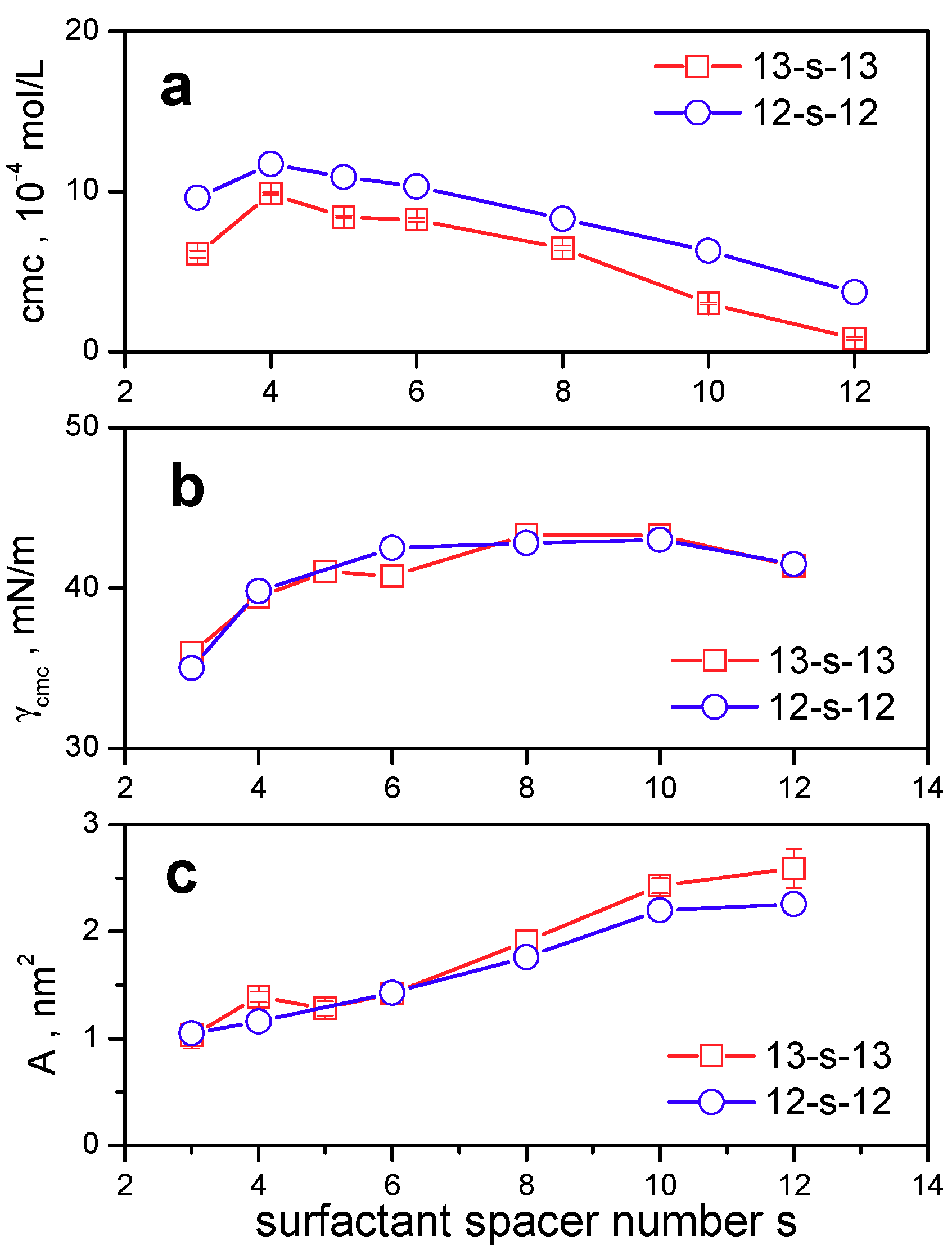

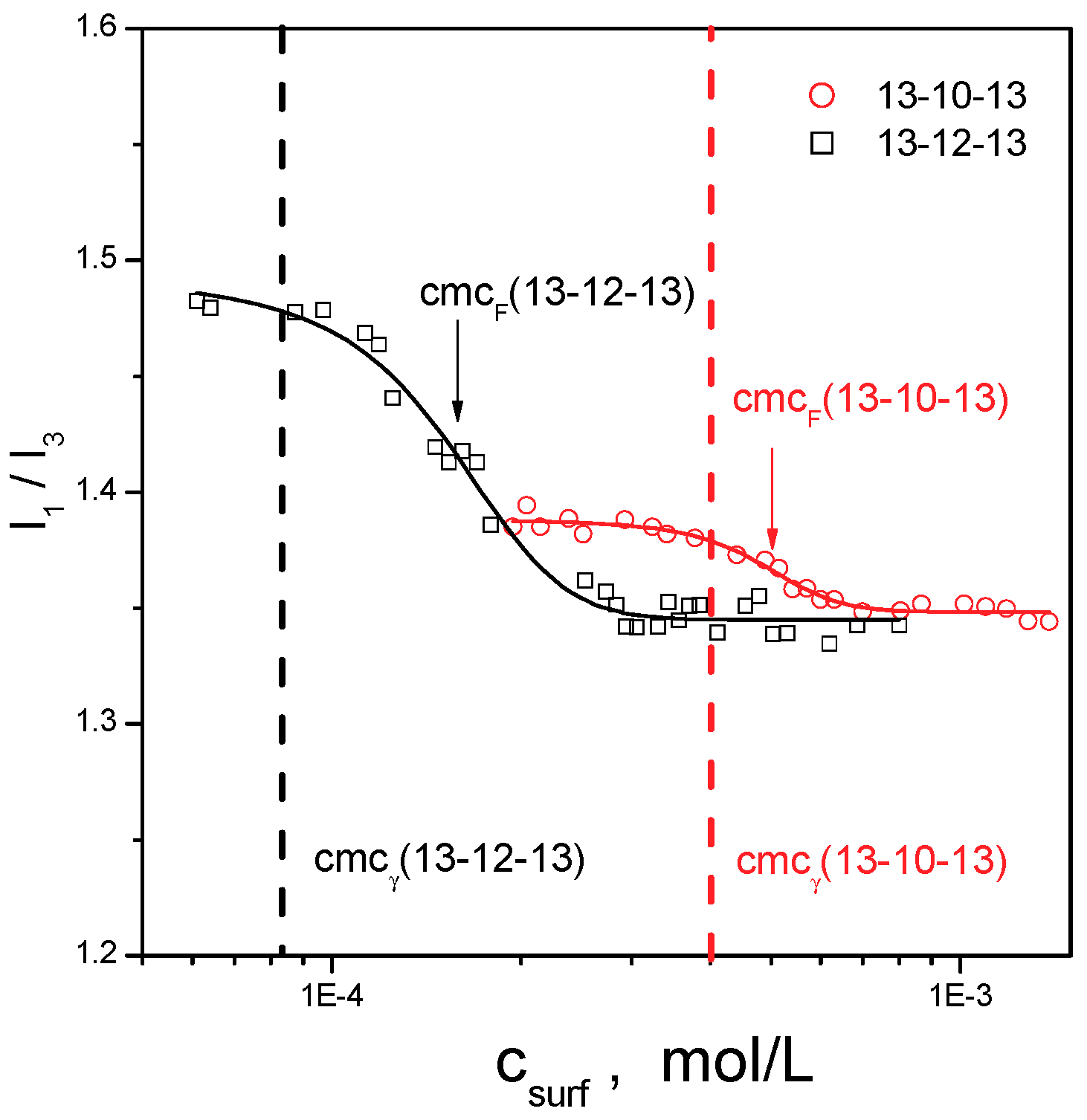
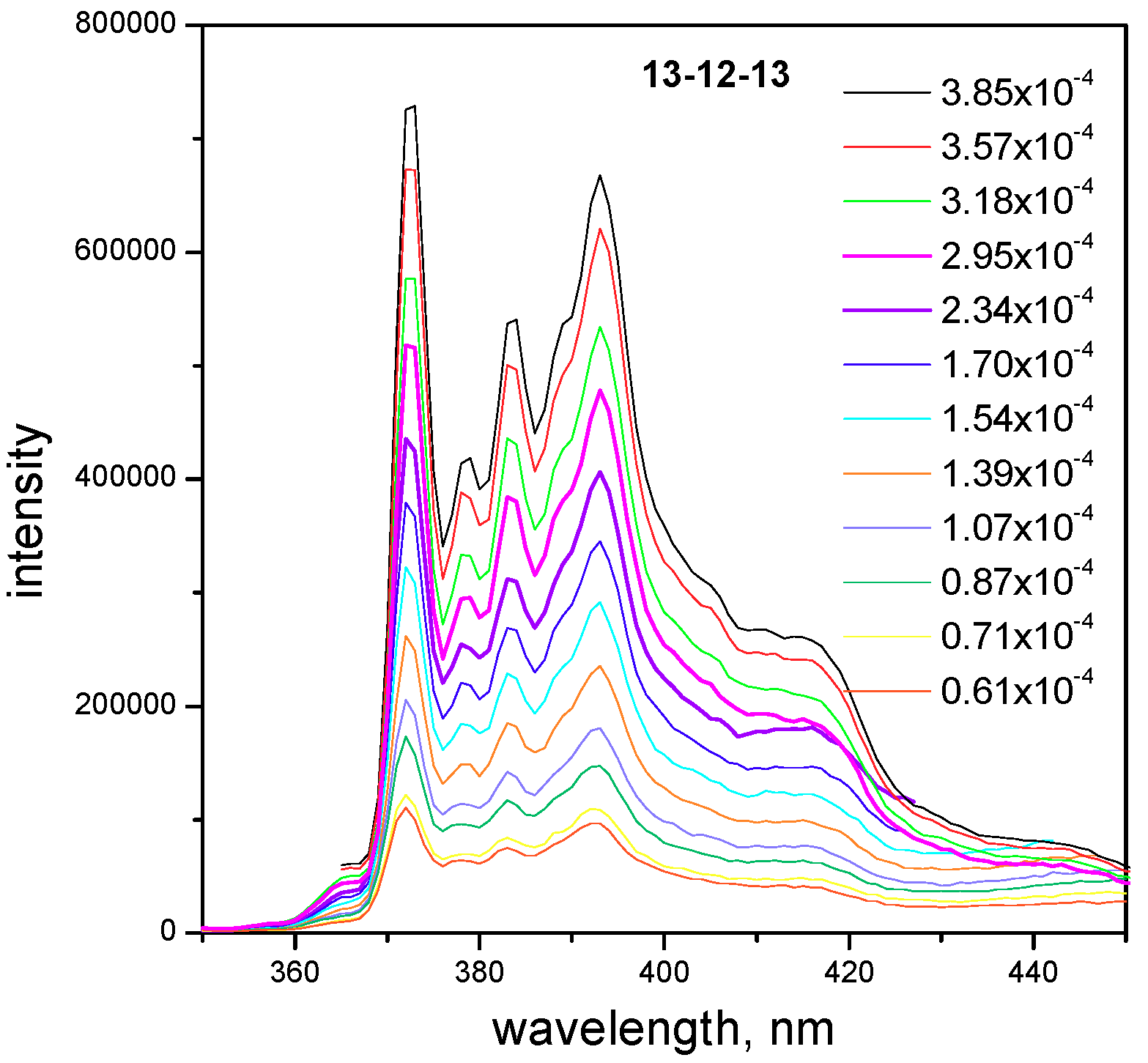
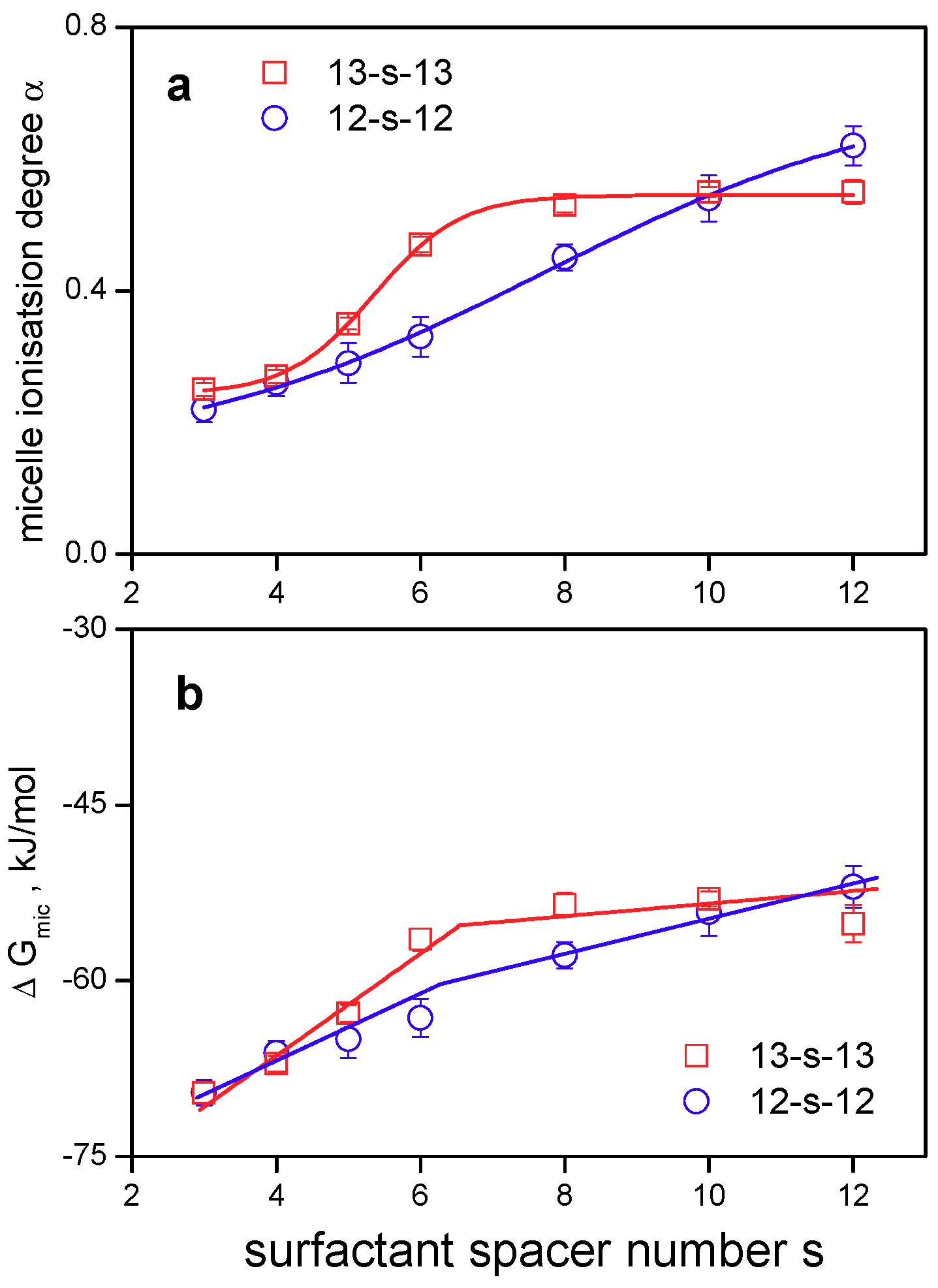
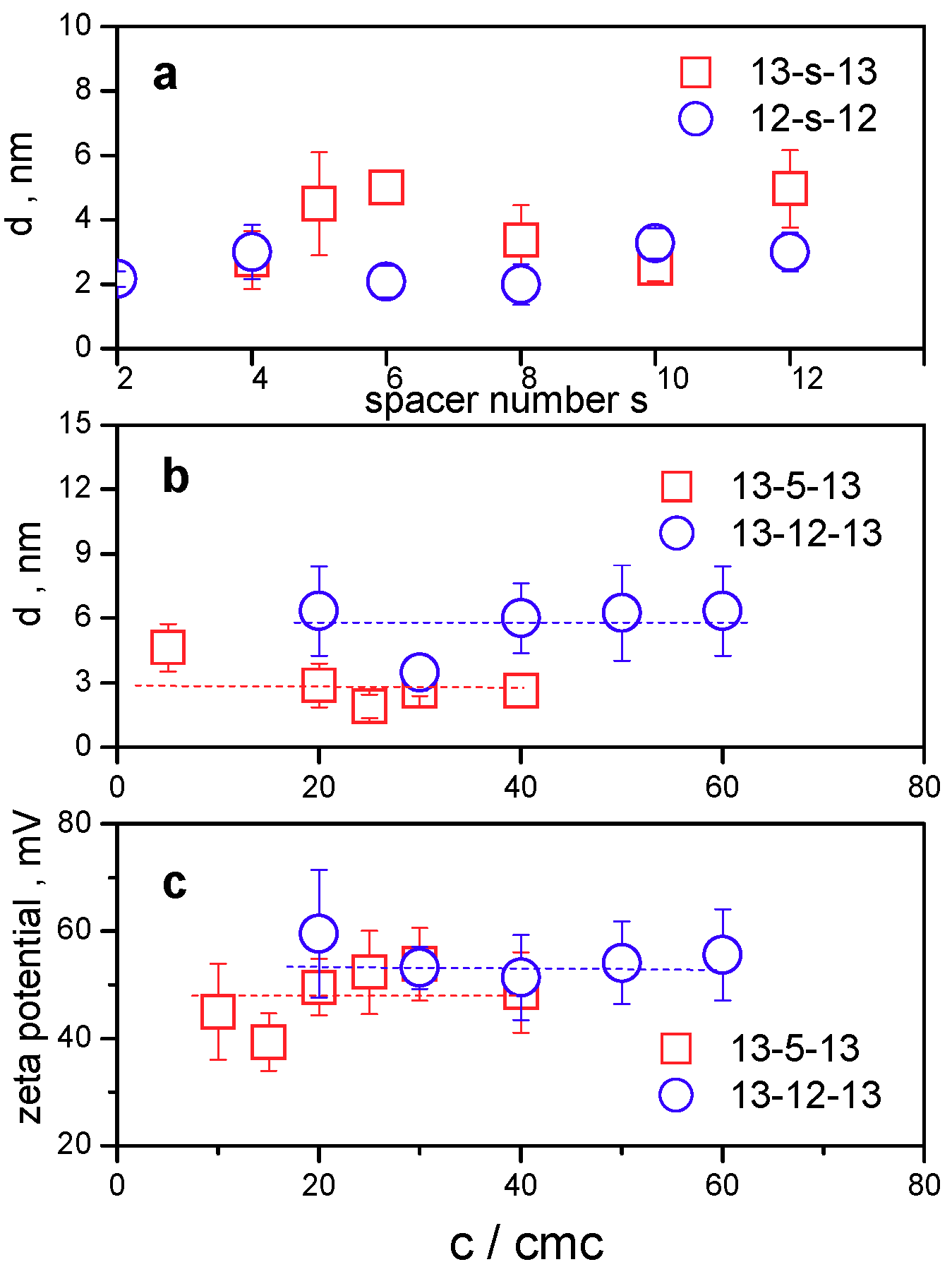
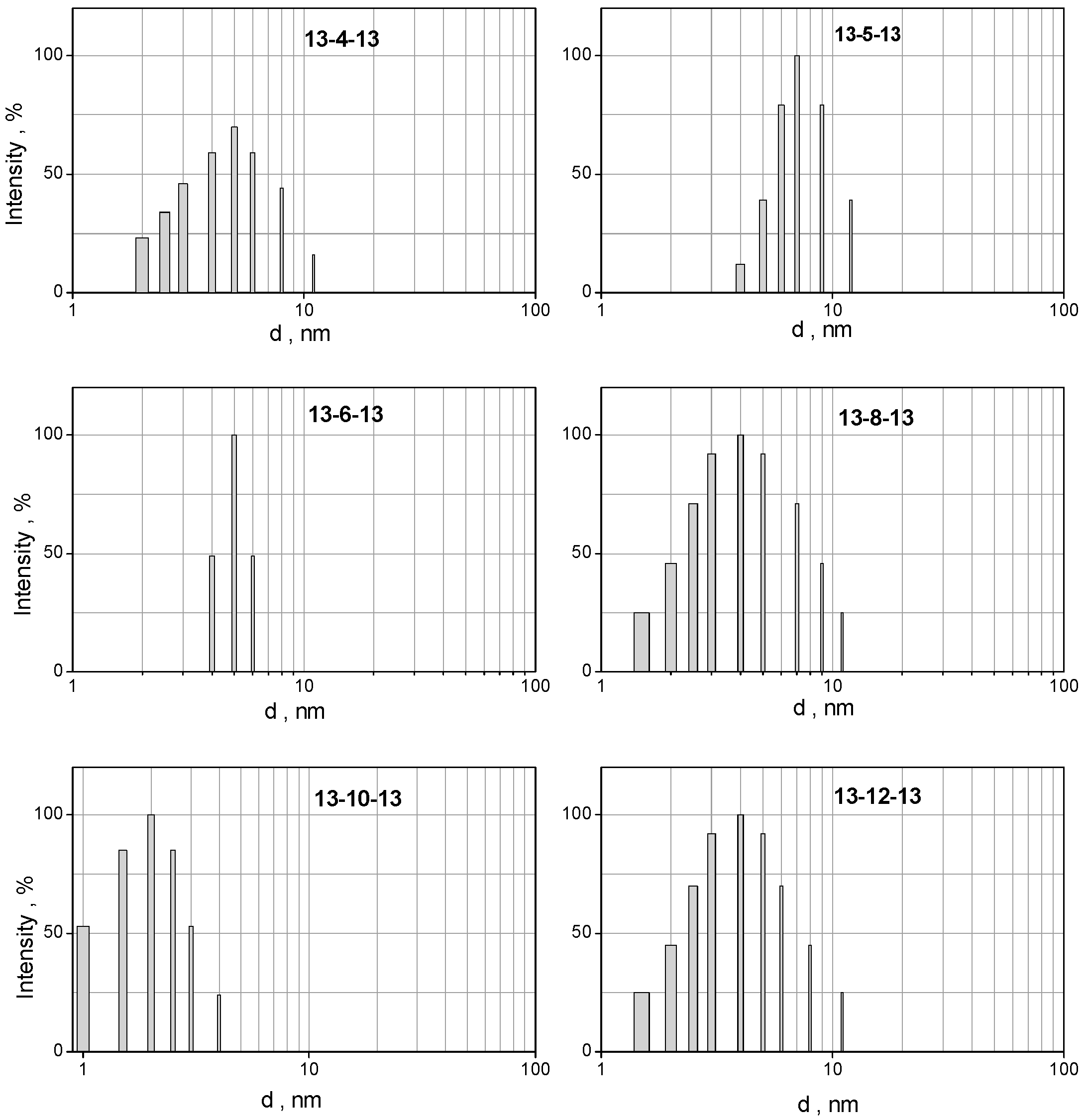
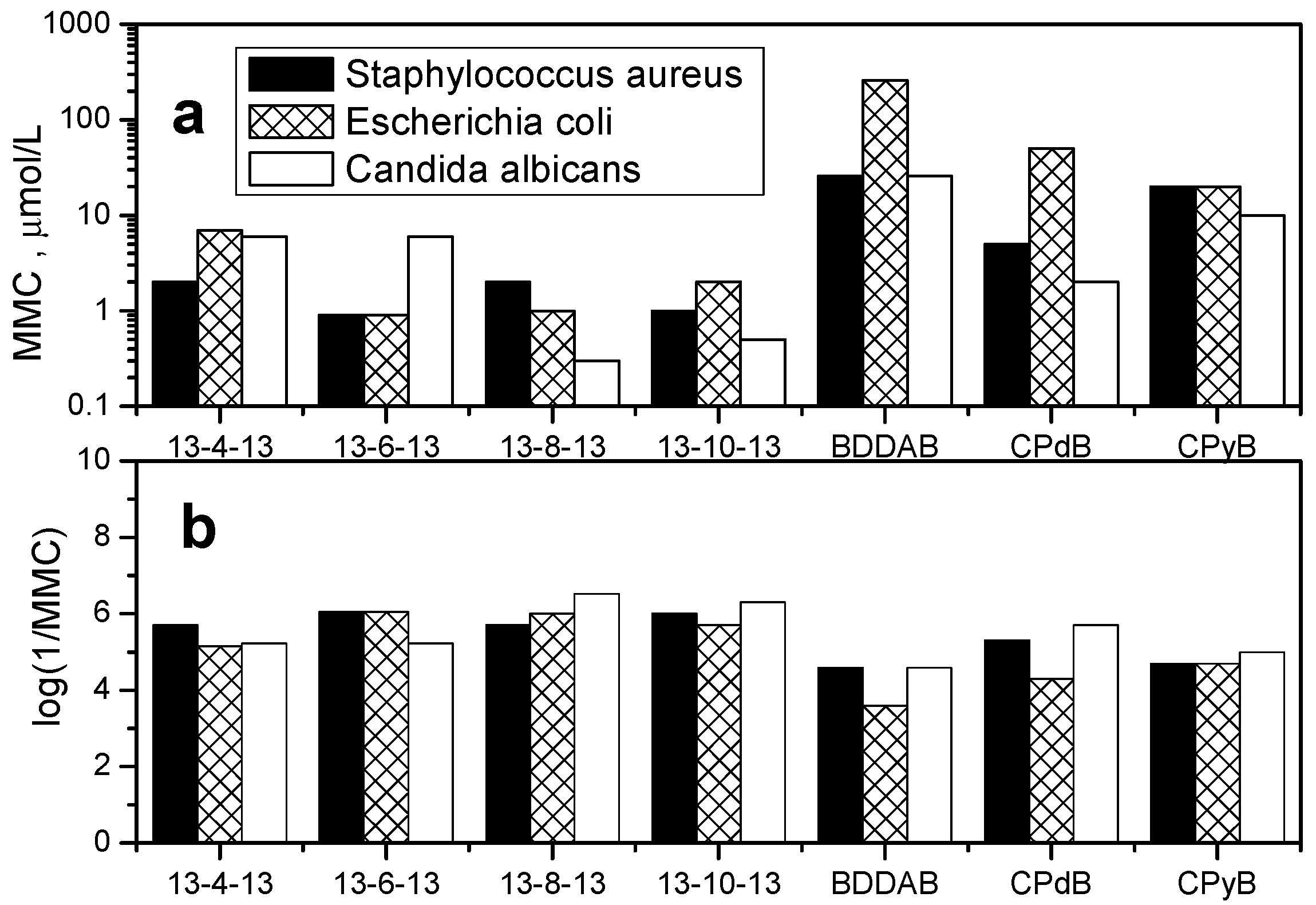
| Gemini Surfactant | cmcγ 10−4 mol/L | cmcσ 10−4 mol/L | γcmc mN/m | A nm2 | a | ΔGmic kJ/mol |
|---|---|---|---|---|---|---|
| 13-3-13 | 6.08 ± 0.21 | 7.35 ± 0.43 | 36.0 | 1.03 ± 0.12 | 0.25 ± 0.02 | −69.6 ± 0.9 |
| 13-4-13 | 9.85 ± 0.09 | 9.20 ± 0.21 | 39.4 | 1.39 ± 0.05 | 0.27 ± 0.02 | −67.1 ± 0.7 |
| 13-5-13 | 8.41 ± 0.07 | 9.12 ± 0.38 | 41.0 | 1.28 ± 0.07 | 0.35 ± 0.03 | −61.1 ± 0.7 |
| 13-6-13 | 8.22 ± 0.13 | 8.68 ± 0.47 | 40.8 | 1.42 ± 0.04 | 0.47 ± 0.03 | −56.5 ± 0.9 |
| 13-8-13 | 6.47 ± 0.15 | 8.13 ± 0.54 | 43.3 | 1.91 ± 0.11 | 0.53 ± 0.01 | −53.5 ± 1.0 |
| 13-10-13 | 3.01 ± 0.07 | 7.16 ± 0.31 | 43.3 | 2.43 ± 0.07 | 0.53 ± 0.01 | −53.0 ± 0.6 |
| 13-12-13 | 0.81 ± 0.07 | 4.55 ± 0.55 | 41.4 | 2.59 ± 0.19 | 0.55 ± 0.02 | −55.1 ± 1.6 |
| Gemini Surfactant | n | A1 | A2 | cmcF 10−4 mol/L | Dx 10−4 mol/L |
|---|---|---|---|---|---|
| 13-10-13 | 24 | 1.39 ± 0.02 | 1.35 ± 0.01 | 4.88 ± 0.14 | 0.71 ± 0.13 |
| 13-12-13 | 30 | 1.50 ± 0.01 | 1.34 ± 0.02 | 1.54 ± 0.06 | 0.35 ± 0.06 |
© 2019 by the authors. Licensee MDPI, Basel, Switzerland. This article is an open access article distributed under the terms and conditions of the Creative Commons Attribution (CC BY) license (http://creativecommons.org/licenses/by/4.0/).
Share and Cite
Pisárčik, M.; Pupák, M.; Lukáč, M.; Devínsky, F.; Hubčík, L.; Bukovský, M.; Horváth, B. The Synthesis, Self-Assembled Structures, and Microbicidal Activity of Cationic Gemini Surfactants with Branched Tridecyl Chains. Molecules 2019, 24, 4380. https://doi.org/10.3390/molecules24234380
Pisárčik M, Pupák M, Lukáč M, Devínsky F, Hubčík L, Bukovský M, Horváth B. The Synthesis, Self-Assembled Structures, and Microbicidal Activity of Cationic Gemini Surfactants with Branched Tridecyl Chains. Molecules. 2019; 24(23):4380. https://doi.org/10.3390/molecules24234380
Chicago/Turabian StylePisárčik, Martin, Matúš Pupák, Miloš Lukáč, Ferdinand Devínsky, Lukáš Hubčík, Marián Bukovský, and Branislav Horváth. 2019. "The Synthesis, Self-Assembled Structures, and Microbicidal Activity of Cationic Gemini Surfactants with Branched Tridecyl Chains" Molecules 24, no. 23: 4380. https://doi.org/10.3390/molecules24234380






